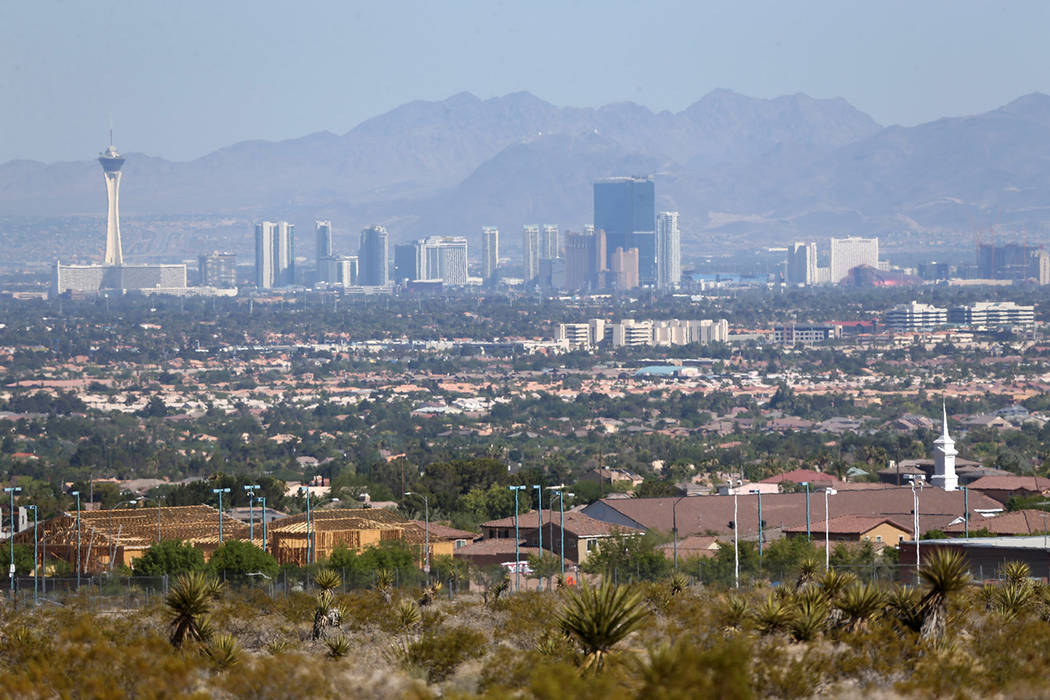Study knocks Las Vegas for ozone, but local officials cite improvement

Cough if you’ve heard this one before: The American Lung Association says Las Vegas has some of the highest ozone levels in the nation, but Clark County air quality officials insist the community is improving when it comes to the smog-causing pollutant.
So who’s got it right?
It looks like they both do.
Las Vegas ranked as the nation’s 13th worst city for ozone pollution in the lung association’s annual “State of the Air” report, released late Tuesday. The community experienced more days of high ozone than the previous year, according to the nationwide report, which is based on data collected by states, cities, counties, tribes and federal agencies.
“Las Vegas residents should be aware that we’re breathing unhealthy air, placing our health and lives at risk,” said JoAnna Strother, director of advocacy for the association in Nevada. “When older adults or children with asthma breathe ozone-polluted air, too often they end up in the doctor’s office, the hospital or the emergency room. Ozone can even shorten life itself.”
But while the number of high ozone days jumped last year to its highest total since 2012, the valley still saw roughly half as many so-called “ozone exceedance days” as it did 15 years ago, according to figures from the Clark County Department of Air Quality.
“Auto emissions continue to improve, which helps lower ground-level ozone,” Mike Sword, the county air quality planning manager, said in a written statement. “The department of air quality also enforces strict compliance with federal, health-based standards on all permitted businesses in Clark County to ensure they are not emitting unhealthy amounts of pollutants into the air.”
Higher standards
Ozone is a colorless gas that exists naturally in the Earth’s upper atmosphere, but at ground level it is a key ingredient of urban smog that can build up during the day in the hottest months of the year. According to the Environmental Protection Agency, exposure to ozone can irritate the respiratory system and cause coughing, sore throat, chest pain and shortness of breath even in healthy people.
In August 2018, the EPA changed its health-based standard for ground-level ozone from 75 to 70 parts per billion. An exceedance occurs when ozone levels rise above 70 ppb over eight hours in a day, something that happened in Las Vegas 35 times last year, up from 18 in 2017.
The new EPA standard certainly played a role in that increase, Sword said, but about half of the community’s ozone exceedances in 2018 can be traced to a spike in the amount of wildfire smoke that blew into Clark County.
The lung association’s “State of the Air” report, now in its 20th year, provides an annual asssesment of the two most widespread outdoor air pollutants, ozone and particles or soot.
This year’s report shows a decrease in year-round levels of particle pollution both in Las Vegas and nationwide, but Strother stressed that roughly four in 10 Americans are still “living with unhealthy air, and we’re heading in the wrong direction when it comes to protecting public health.”
For example, the report highlights increased ozone levels in most cities nationwide and warns that warmer temperatures brought on by climate change make ozone more likely to form and harder to clean up.
Eight of the top 11 most ozone-polluted metropolitan areas are in California, with Los Angeles topping this year’s list — just as it has in 19 if the 20 years the report has been produced. The cleanest city for ozone pollution is Anchorage, Alaska.
Ozone season
Starting April 1, county air quality officials declared a seasonal ozone advisory for the Las Vegas Valley through Sept. 30.
Residents are encouraged to reduce their ozone output by driving and idling their vehicles less, sticking to public transportation when possible and filling up their gas tanks after dark.
Those with respiratory problems and other health issues are advised to limit outdoor activity, especially in the middle of the day when levels are at their worst, and stick to less strenuous exercise in the morning or evening.
In part due to the EPA’s new standard, Clark County is currently in “marginal” non-attainment status for ground-level ozone, the agency’s lowest classification.
“For the Department of Air Quality, this new, lower bar by the EPA simply means we have to limbo lower, which we will do,” Sword said. “We beat dust and we beat carbon monoxide. Now, we will beat ozone.”
Contact Henry Brean at hbrean@reviewjournal.com or 702-383-0350. Follow @RefriedBrean on Twitter.
SOTA 2019 Full Report by on Scribd